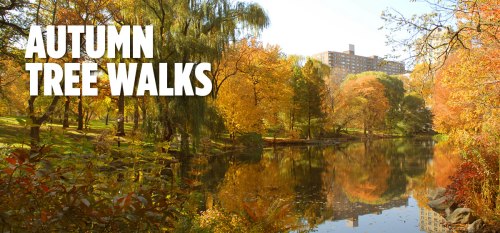Cooler weather is finally turning NYC into a technicolor extravaganza, and some of the best fall foliage is in the middle of Manhattan.
Central Park is home to more than 170 species of trees - some 18,000 in total - now turning glorious shades of yellow, orange and red.
Here’s what to look for, and where, according to Alan Clark, a top arborist with the Central Park Conservancy, and part of the team which prunes, inspects, and keeps the park’s roughly 18,000 trees healthy year-round.
Sugar maple
“Sugar maples are the most iconic trees for fall foliage,” Alan says.
There are dozens of sugar maples, famous for turning a spectacular orange, throughout Central Park, and in other NYC parks.
Other maples include including the red maple, Norway maple, and sycamore maple.
This genus of trees is known for its tasty syrup, its presence on the Canadian flag, and its beautiful autumn colors.

Where to find the sugar maple:
- West side: The Pool; south of Tavern on the Green
- Mid-Park: East side of Sheep Meadow
- East side: Southeast area of the North Meadow
Black tupelo
In addition to its bright orange and crimson colors each fall, the black tupelo grows berries that attract migratory birds. Its leaves change colors and drop around the same time that its fruits ripen.
“Watch this tree fade from yellow to fire-engine red in the span of a few weeks,” Alan explains, “and then suddenly, you’ll see all these songbirds fluttering around and chowing down on its berries.”
One of Central Park’s most iconic spots for fall foliage is the Ramble’s Tupelo Meadow. Here is where to find a magnificent three-trunked black tupelo offering a colorful fall foliage display, alongside many serviceberry, London plane, and American elm trees.
Where to find the black tupelo:
- West side: The Pool
- Mid-Park: Throughout the Ramble
- East side: Landscape between Alice in Wonderland and Glade Arch; southeast corner of the Pond
Green ash
Ash trees, such as the green ash, can turn a variety of colors each fall, from purple to orange to golden yellow. They are popular urban trees that are at risk of going extinct because of the invasive, imported emerald ash borer beetle. For that reason, the green ash is a good tree to appreciate in all seasons, Alan says. In addition, ash trees represent the Tree of Life in mythology.
Where to find the green ash:
- West side: Northeast of Tavern on the Green; east of Diana Ross Playground
- East side: The Harlem Meer; south of the Dairy Visitor Center & Gift Shop
Sweetgum
There are more than 100 sweetgum in Central Park, and it was likely growing wild in the area before the Park’s construction.
Arguably offering the widest color range of all the Park’s tree species, it can turn purple, orange, red, or even pink. Sweetgums have star-shaped leaves, making them pretty no matter the season.
Where to find the sweetgum:
- West side: The Pool; throughout the North Woods
- Mid-Park: South end of the Ramble
Coniferous deciduous trees
It’s rare when trees are both coniferous (which means they have needles and produce cones) and deciduous (which means they lose their leaves each winter). However, there are a few of these trees in Central Park—and they also offer fall foliage.
The European larch and the American larch feature needles that turn yellow-gold before dropping to the ground each fall.
Alan recommends heading to the west side to find larch trees in Strawberry Fields and north of the Delacorte Theater.
The needles on the bald cypress—found at the south end of Cedar Hill, near Gapstow Bridge, and at the Harlem Meer—turn golden-yellow and bronze each fall.
The dawn redwood is another coniferous deciduous tree with needles that turn reddish-bronze. This tree can be found at Strawberry Fields and southwest of the Conservatory Garden.
Share your fall foliage finds
Alan suggests several other trees for fall foliage, from pin oaks to gingkos.
Visit the Bloom & Tree Guide to learn more about these and other species found in Central Park.
Download Central Park’s fall foliage map to know where to visit this season.
Share your fall foliage photos. Tag @CentralParkNYC and use the hashtag #CentralParkFoliageWatch.
Share your photos with us, too. Tag @nyccheap.
This article is adapted from one on the Central Park Conservancy website.


What do you think about this? We welcome your comments.